Hive语法及其进阶(二)
1、使用JDBC连接Hive
1 import java.sql.Connection; 2 import java.sql.DriverManager; 3 import java.sql.PreparedStatement; 4 import java.sql.ResultSet; 5
6 public class HiveDemo { 7 public static void main(String[] args) throws Exception { 8 Class.forName("org.apache.hive.jdbc.HiveDriver"); 9 //"jdbc:hive2://master:10000/test3"
10 Connection connection = DriverManager.getConnection("jdbc:hive2://master:10000/myhive"); 11 String sql="select * from students"; 12 PreparedStatement ps = connection.prepareStatement(sql); 13 ResultSet rs = ps.executeQuery(); 14 while (rs.next()){ 15 int id = rs.getInt(1); 16 String name = rs.getString(2); 17 int age = rs.getInt(3); 18 String gender = rs.getString(4); 19 String clazz = rs.getString(5); 20 System.out.println(id + "," + name + "," + age + "," + gender + "," + clazz); 21 } 22 rs.close(); 23 ps.close(); 24 connection.close(); 25 } 26 }
2、Hive常用函数
1.关系运算
// 等值比较 = == <=>
// 不等值比较 != <>
// 区间比较: select * from default.students where id between 1500100001 and 1500100010;
// 空值/非空值判断:is null、is not null、nvl()、isnull()
| 操作符 |
支持的数据类型 |
描述 |
| A=B |
基本数据类型 |
如果A等于B则返回TRUE,反之返回FALSE |
| A<=>B |
基本数据类型 |
如果A和B都为NULL,则返回TRUE,如果一边为NULL,返回False |
| A<>B, A!=B |
基本数据类型 |
A或者B为NULL则返回NULL;如果A不等于B,则返回TRUE,反之返回FALSE |
| A<B |
基本数据类型 |
A或者B为NULL,则返回NULL;如果A小于B,则返回TRUE,反之返回FALSE |
| A<=B |
基本数据类型 |
A或者B为NULL,则返回NULL;如果A小于等于B,则返回TRUE,反之返回FALSE |
| A>B |
基本数据类型 |
A或者B为NULL,则返回NULL;如果A大于B,则返回TRUE,反之返回FALSE |
| A>=B |
基本数据类型 |
A或者B为NULL,则返回NULL;如果A大于等于B,则返回TRUE,反之返回FALSE |
| A [NOT] BETWEEN B AND C |
基本数据类型 |
如果A,B或者C任一为NULL,则结果为NULL。如果A的值大于等于B而且小于或等于C,则结果为TRUE,反之为FALSE。如果使用NOT关键字则可达到相反的效果。 |
| A IS NULL |
所有数据类型 |
如果A等于NULL,则返回TRUE,反之返回FALSE |
| A IS NOT NULL |
所有数据类型 |
如果A不等于NULL,则返回TRUE,反之返回FALSE |
| IN(数值1, 数值2) |
所有数据类型 |
使用 IN运算显示列表中的值 |
| A [NOT] LIKE B |
STRING 类型 |
B是一个SQL下的简单正则表达式,也叫通配符模式,如果A与其匹配的话,则返回TRUE;反之返回FALSE。B的表达式说明如下:‘x%’表示A必须以字母‘x’开头,‘%x’表示A必须以字母’x’结尾,而‘%x%’表示A包含有字母’x’,可以位于开头,结尾或者字符串中间。如果使用NOT关键字则可达到相反的效果。 |
| A RLIKE B, A REGEXP B |
STRING 类型 |
B是基于java的正则表达式,如果A与其匹配,则返回TRUE;反之返回FALSE。匹配使用的是JDK中的正则表达式接口实现的,因为正则也依据其中的规则。例如,正则表达式必须和整个字符串A相匹配,而不是只需与其字符串匹配。 |

2 .数值计算
取整函数(四舍五入):round
向上取整:ceil
向下取整:floor
like、rlike、
(1)查找名字以A开头的员工信息
hive (default)> select * from emp where ename LIKE 'A%';
(2)查找名字中第二个字母为A的员工信息
hive (default)> select * from emp where ename LIKE '_A%';
(3)查找名字中带有A的员工信息
hive (default)> select * from emp where ename RLIKE '[A]';
.
3.日期函数
1 select from_unixtime(1610611142,'YYYY/MM/dd HH:mm:ss'); 2unix_timestamp(),获取当前时间的时间戳
3 select from_unixtime(unix_timestamp(),'YYYY/MM/dd HH:mm:ss');
4 // '2021年01月14日' -> '2021-01-14'
6 select from_unixtime(unix_timestamp('2021年01月14日','yyyy年MM月dd日'),'yyyy-MM-dd');
8 select from_unixtime(unix_timestamp("04-2021-16","MM-yyyy-dd"),"yyyy/MM/dd");
4.字符串函数
1)cancat()字符串拼接 当有空值则为NULL
2)cancat_ws()指定可以指定分隔符,并且会自动忽略NULL
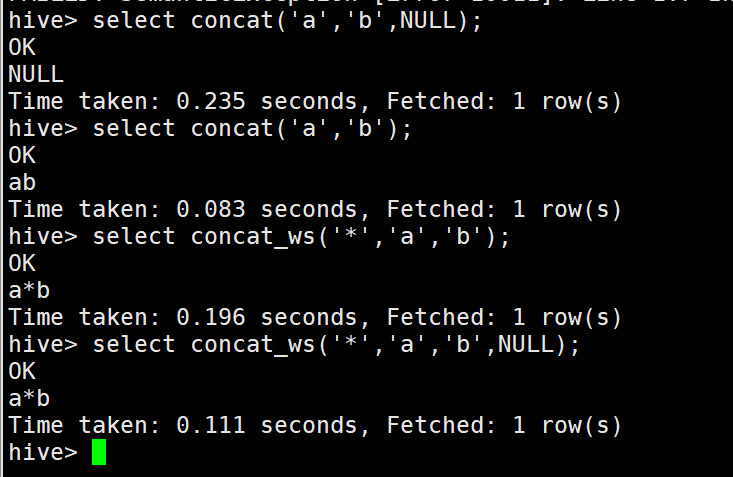 3)substring字符串的截取
3)substring字符串的截取
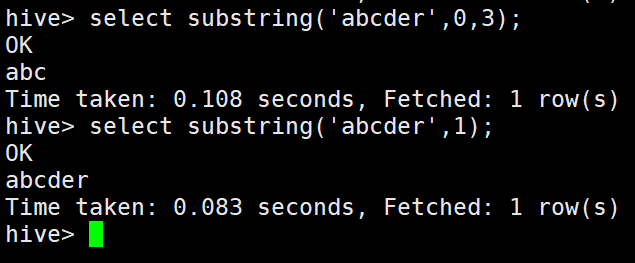
4)split字符串的切分
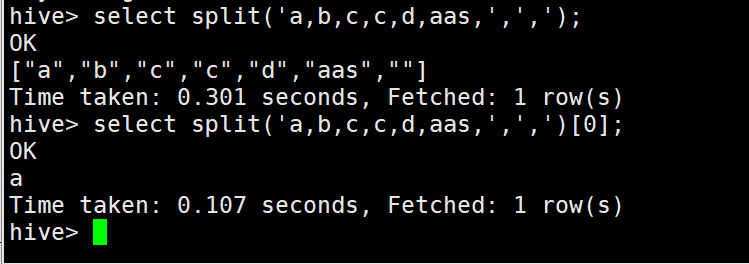
5)explode列转行

解析json格式的数据
select get_json_object
('{"name":"zhangsan",
"age":18,
"score":[{"course_name":"math","score":100},{"course_name":"english","score":60}]}',
"$.score[0].score");

6) Hive中的wordcount
create table words( words string )row format delimited fields terminated by '|'; // 数据 hello,java,hello,java,scala,python hbase,hadoop,hadoop,hdfs,hive,hive hbase,hadoop,hadoop,hdfs,hive,hive select word,count(*) from (select explode(split(words,',')) word from words) a group by a.word;
4.开窗函数
##### row_number:无并列排名
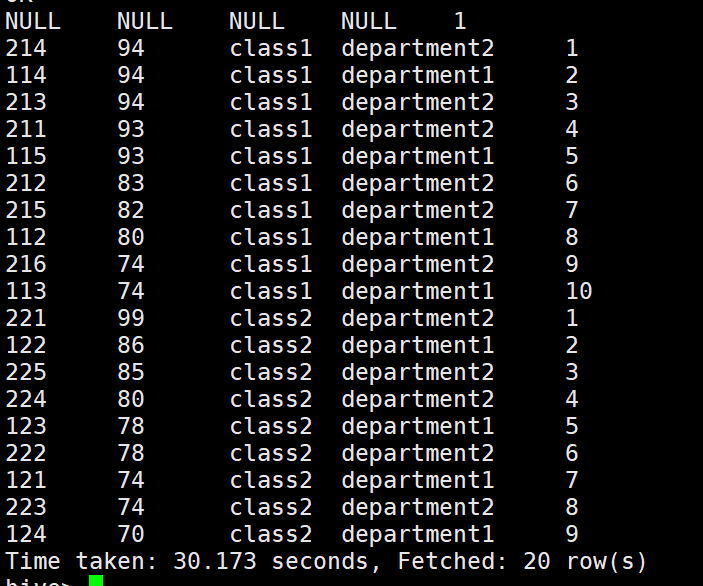
分组求TOPN
select * from (select *, row_number() over(partition by clazz order by score desc)as s from new_score)tt where tt.s<=3;
用法: select xxxx, row_number() over(partition by 分组字段 order by 排序字段 desc) as rn from tb group by xxxx
##### dense_rank:有并列排名,并且依次递增
hive> select *, row_number() over(partition by clazz order by score desc)as s, > dense_rank() over(partition by clazz order by score desc)as s from new_score;
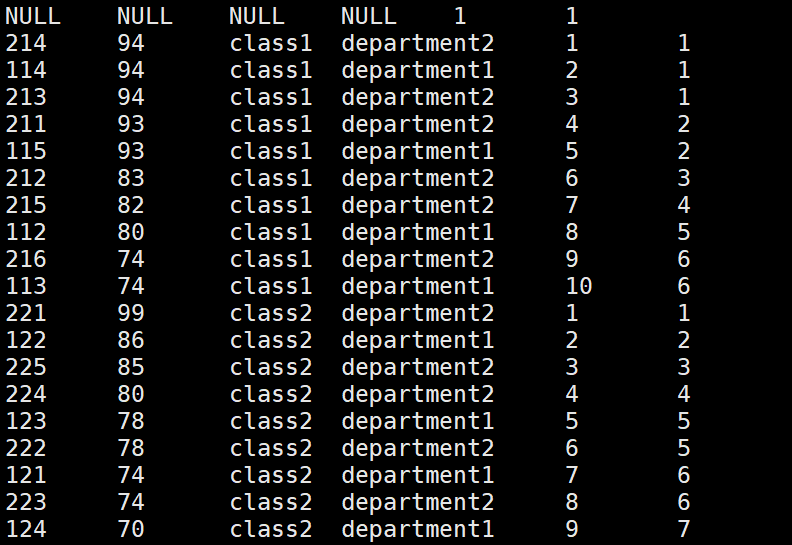
##### rank:有并列排名,不依次递增
hive> select *, row_number() over(partition by clazz order by score desc)as s, > dense_rank() over(partition by clazz order by score desc), > rank() over(partition by clazz order by score desc)from new_score;
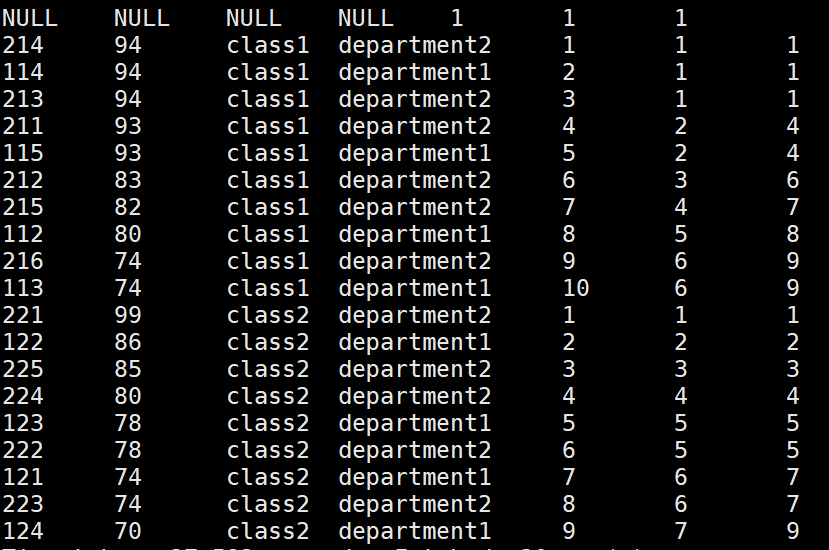
##### percent_rank:(rank的结果-1)/(分区内数据的个数-1)
select *, row_number() over(partition by clazz order by score desc)as s,
> rank() over(partition by clazz order by score desc),
> percent_rank() over(partition by clazz order by score desc)from new_score;

##### cume_dist:计算某个窗口或分区中某个值的累积分布。
select *, row_number() over(partition by clazz order by score desc)as s, > rank() over(partition by clazz order by score desc), > percent_rank() over(partition by clazz order by score desc), > cume_dist() over(partition by clazz order by score desc) from new_score;

> 假定升序排序,则使用以下公式确定累积分布: 小于等于当前值x的行数 / 窗口或partition分区内的总行数。其中,x 等于 order by 子句中指定的列的当前行中的值。
##### NTILE(n):对分区内数据再分成n组,然后打上组号
##### max、min、avg、count、sum:基于每个partition分区内的数据做对应的计算
5.窗口帧格式
格式1:按照行的记录取值
ROWS BETWEEN (UNBOUNDED | [num]) PRECEDING AND ([num] PRECEDING | CURRENT ROW | (UNBOUNDED | [num]) FOLLOWING)
格式2:当前所指定值的范围取值
RANGE BETWEEN (UNBOUNDED | [num]) PRECEDING AND ([num] PRECEDING | CURRENT ROW | (UNBOUNDED | [num]) FOLLOWING)
注意:
UNBOUNDED:无界限
CURRENT ROW:当前行
rows格式1:前2行+当前行+后两行
sum(score) over (partition by clazz order by score desc rows between 2 PRECEDING and 2 FOLLOWING)
rows格式2:前记录到最末尾的总和
sum(score) over (partition by clazz order by score desc rows between CURRENT ROW and UNBOUNDED FOLLOWING)
range格式1: 如果当前值在80,取值就会落在范围在80-2=78和80+2=82组件之内的行
max(score) over (partition by clazz order by score desc range between 2 PRECEDING and 2 FOLLOWING)
目录 返回
首页